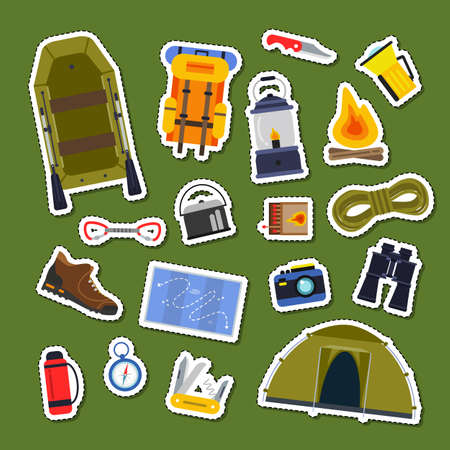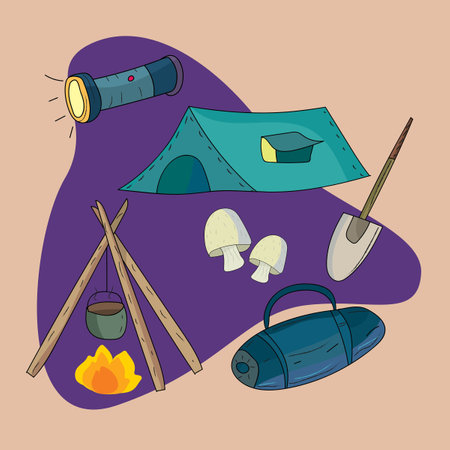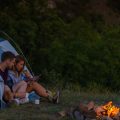1. Choosing the Right Gear for Your Trip
When youre heading out on your first camping trip, picking the right gear is a big deal. The kind of equipment you need can change depending on where youre going and what time of year it is. Whether its a chilly mountain getaway or a warm summer weekend by the lake, having the right setup can make all the difference in how comfortable and safe your trip will be.
Start with the Basics: Tent, Sleeping Bag, and Sleeping Pad
These three items are your core sleeping system, and they need to match your destination’s weather and terrain.
Tents
A good tent keeps you dry, warm, and protected from bugs. For beginners, go with something easy to set up but sturdy enough for unexpected weather.
| Type | Best For | Features to Look For |
|---|---|---|
| 3-Season Tent | Mild weather (spring, summer, fall) | Lightweight, good ventilation, rainfly included |
| 4-Season Tent | Cold or snowy conditions | Sturdy poles, strong fabric, less ventilation |
Sleeping Bags
Your sleeping bag should match the lowest temperature you expect at night. It’s better to be too warm than too cold.
| Temperature Rating | Season | Recommended Use |
|---|---|---|
| 35°F and above | Summer | Lakeside or low elevation trips |
| 20°F to 35°F | Spring/Fall | Campsites with cooler nights |
| Below 20°F | Winter | Mountain or high elevation camping |
Sleeping Pads
A sleeping pad adds comfort and insulation between you and the ground. Even in summer, the earth can suck heat from your body overnight.
- Foam Pads: Affordable and durable; great for car camping.
- Inflatable Pads: More comfortable; ideal for backpacking or longer trips.
- Semi-Self Inflating: A balance of comfort and packability.
Packing Based on Weather and Location
If youre camping in a national park in Utah during summer, youll want breathable gear and sun protection. But if youre heading to Yosemite in early spring, pack warmer layers and waterproof items. Always check local forecasts before you leave — weather can change fast in many parts of the U.S., especially in mountain areas.
A Quick Checklist for First-Time Campers by Season:
| Sumer Camping | Cool Weather Camping | |
|---|---|---|
| Tent Type | 3-season with ventilation | 4-season or sturdy 3-season with full rainfly |
| Sleeping Bag Rating | >35°F rating | <30°F rating (or lower) |
| Pads & Insulation | Slim inflatable or foam pad is okay | Add extra insulation under pad if cold ground expected |
Selecting the right gear doesn’t have to be overwhelming. Start simple, buy or rent quality beginner-friendly equipment that matches your destinations climate and terrain. As you gain experience, you’ll learn what works best for your style of camping.
2. What to Wear: Clothing Essentials for the OutdoorsDress for success in the wild! When youre heading out on your first camping trip, knowing what to wear can make all the difference between a great time and a miserable one. Weather can change fast in the great outdoors, so it’s important to be prepared with the right clothing layers, sturdy footwear, and rain protection.
Layering is Key
The best way to stay comfortable outdoors is by dressing in layers. This gives you the flexibility to add or remove clothing as temperatures shift throughout the day.
| Layer | Purpose | Examples |
|---|---|---|
| Base Layer | Wicks moisture away from skin | Moisture-wicking t-shirts, thermal underwear (avoid cotton) |
| Mid Layer | Provides insulation | Fleece jacket, down vest, hoodie |
| Outer Layer | Protects against wind and rain | Waterproof jacket, windbreaker, rain pants |
Choose Proper Footwear
Your feet will do most of the work on a camping trip—especially if hiking is part of your plan. Invest in a good pair of hiking boots or trail shoes that are broken-in before your trip. Pair them with moisture-wicking socks (wool or synthetic) to help prevent blisters and keep your feet dry.
Footwear Tips:
- Avoid new shoes—break them in ahead of time.
- Pack an extra pair of socks for each day.
- If it’s going to be wet, consider waterproof boots or gaiters.
Don’t Forget Rain Protection
No matter what the forecast says, always bring some form of rain gear. A sudden downpour can turn fun into frustration if youre not ready for it. Lightweight, packable rain jackets and pants are easy to carry and can save the day when clouds roll in.
Pro Tip:
A poncho may seem like enough, but it doesn’t offer as much protection or mobility as a well-fitted rain jacket and pants combo. Look for breathable materials that won’t trap sweat underneath.

3. Food, Water, and Cooking Supplies
When youre heading out for your first camping trip, figuring out what to bring for meals can feel overwhelming. But don’t worry — with a little planning and the right gear, you’ll be eating well in the great outdoors. Here’s how to make sure you pack smart when it comes to food, water, and cooking supplies.
Meal Planning Made Easy
Start by planning each meal ahead of time. Think about how many days youll be camping, how many people are in your group, and whether you’ll have access to a cooler or camp stove. Keep meals simple — think sandwiches, pre-cooked pasta, canned chili, or foil-pack dinners you can cook over the fire.
Sample Meal Plan for a Weekend Trip
| Meal | Food Ideas |
|---|---|
| Breakfast | Instant oatmeal, granola bars, fruit, coffee |
| Lunch | Deli meat sandwiches, chips, trail mix |
| Dinner | Hot dogs, baked beans, s’mores |
Food Storage Tips
If you’re bringing perishable items like meat or dairy, you’ll need a cooler with plenty of ice or ice packs. Store dry goods like bread and snacks in airtight containers or resealable bags to keep bugs and moisture out. Always keep your food locked up in a vehicle or bear-proof container if youre camping in bear country.
Food Storage Checklist
- Cooler with ice/ice packs
- Airtight containers or zip-top bags
- Bear-proof storage (if needed)
- Trash bags for cleanup
Cooking Gear Essentials
You don’t need a full kitchen setup — just a few key tools can make cooking at camp easy and enjoyable. Here’s what most first-time campers find useful:
Basic Camp Kitchen Gear
- Portable stove or grill (plus fuel)
- Lighter and waterproof matches
- Pots and pans (1–2 is usually enough)
- Cooking utensils: spatula, tongs, spoon
- Eating utensils: forks, knives, spoons
- Plates and bowls (durable & reusable)
- Cups or mugs for drinks
- Sponge and biodegradable soap for cleanup
Water Safety and Storage Tips
You’ll need clean drinking water for everyone in your group — not just for drinking but also for cooking and cleaning. If your campsite doesn’t have potable water available, plan to bring your own or purify it on-site using filters or purification tablets.
Water Prep Options
| Method | Description |
|---|---|
| Bottled Water | Easy but heavy; plan about one gallon per person per day. |
| Water Jugs/Containers | Reusable option; great for base camps with car access. |
| Water Filter or Purifier | Treats natural sources like rivers or lakes; essential for backcountry trips. |
| Purisafe Tablets/Drops | Lightweight backup method; requires waiting time before safe to drink. |
Packing the right food and kitchen gear makes a huge difference in your camping experience. With some basic prep work and the essentials above, you’ll be ready to cook up tasty meals and stay hydrated wherever your adventure takes you.
4. Toiletries and Personal Items
Don’t forget the small stuff. When you’re out in the woods or at a campground, staying fresh and feeling comfortable can make a big difference. First-time campers often focus on gear like tents and sleeping bags but overlook the personal essentials that keep daily routines on track. Heres what you really need to pack for hygiene and personal care during your camping trip.
Must-Have Toiletries
Even if youre roughing it, basic cleanliness is still important. Pack travel-sized versions of these items to save space:
| Item | Why You Need It |
|---|---|
| Toothbrush & Toothpaste | Keep your mouth fresh and healthy even when theres no bathroom around. |
| Biodegradable Soap | For washing hands, face, or even dishes without harming nature. |
| Deodorant | You’ll appreciate it after a day of hiking or sitting by the campfire. |
| Wet Wipes or Baby Wipes | Great for quick clean-ups when showers arent available. |
| Toilet Paper (camp-friendly) | Most campsites don’t provide it—bring your own just in case. |
| Sunscreen | Protects your skin from sunburn during outdoor activities. |
| Bug Spray or Insect Repellent | Mosquitoes and ticks can be brutal depending on where you camp. |
Medications & First Aid Basics
If you take any daily medications, make sure to pack enough for your entire trip plus a little extra. Accidents can happen outdoors, so having a small personal first-aid kit is always smart. Here are some common items to include:
- Pain relievers (like ibuprofen or acetaminophen)
- Band-aids and antiseptic wipes
- Allergy medicine (especially if youre sensitive to pollen or insect bites)
- Tweezers (for splinters or ticks)
- Lip balm with SPF
Other Personal Essentials
A few more things that are easy to forget but can make your experience way more comfortable:
- Towel (quick-dry microfiber ones are best for camping)
- Hairbrush or comb
- Hand sanitizer
- Nail clippers (you’d be surprised how handy these are!)
- Contact lenses and solution or glasses, if needed
- Feminine hygiene products (even if you don’t expect to need them)
Packing Tip:
Use a small zippered bag or hanging toiletry organizer to keep all your personal items in one place. This makes it easier to find what you need quickly and keeps things tidy around camp.
Quick Reminder:
If youre camping somewhere with bears or other wildlife, store scented toiletries in a bear-proof container away from your sleeping area—just like you would with food!
The goal is to stay clean, safe, and comfortable without overpacking. By thinking ahead and organizing these little necessities, you’ll avoid those “I wish I had brought…” moments at camp.
5. Safety, Navigation, and Emergency Prep
When youre heading out into the great outdoors for the first time, staying safe should be a top priority. Nature is beautiful, but it can also be unpredictable. Packing the right safety and emergency gear helps you stay prepared for anything that comes your way.
First-Aid Kit Essentials
A basic first-aid kit is a must-have on any camping trip. You don’t need a full-blown medical bag, but make sure your kit includes:
| Item | Why You Need It |
|---|---|
| Bandages (various sizes) | For cuts, blisters, and scrapes |
| Antiseptic wipes | To clean wounds |
| Tweezers | For removing splinters or ticks |
| Pain relievers (like ibuprofen) | Helps with headaches, soreness, or minor injuries |
| Allergy meds (like Benadryl) | Just in case of unexpected reactions to plants or insect bites |
Navigation Tools You Can Trust
Even if you plan to camp at a well-marked site, it’s smart to bring reliable navigation tools. Technology is great—until your phone dies or loses signal. Here’s what we recommend:
- Physical map of the area: Always keep a paper map as backup.
- Compass: A classic tool that doesn’t rely on batteries.
- GPS device: Helpful for backcountry hikes or off-grid areas.
- Headlamp or flashlight with extra batteries: For navigating in the dark or during power outages.
Bear Safety and Wildlife Awareness
If youre camping in bear country—or anywhere with active wildlife—you’ll want to take extra precautions. Follow these tips to avoid unwanted animal encounters:
- Store food properly: Use bear-proof containers or hang food away from your tent and high off the ground.
- No food in the tent: Keep snacks and scented items out of your sleeping area.
- Make noise while hiking: This alerts animals that humans are around and reduces surprise encounters.
- Carry bear spray: Especially if you’re exploring deeper into wild areas; know how to use it before your trip.
Pro Tip:
If youre unsure about local wildlife risks, check with park rangers or campground staff. They can offer specific advice based on the season and location.
Emergency Contact and Backup Plans
You never know when plans might change or emergencies arise. Before you head out, make sure someone knows where youll be and when you expect to return. Also consider bringing a whistle or personal locator beacon (PLB) for emergencies in remote areas.
Your Safety Checklist:
- [ ] First-aid kit packed and complete
- [ ] Flashlight/headlamp with fresh batteries
- [ ] Paper map and compass packed
- [ ] Food stored properly for wildlife safety
- [ ] Emergency contact informed of your trip details
- [ ] Bear spray packed (if applicable)
Packing smart for safety doesn’t have to be overwhelming. With just a few essential items and some simple prep, you’ll feel more confident and secure during your camping adventure.
6. Leave No Trace: Packing for Responsible Camping
When youre heading out for your first camping trip, its important to think beyond just what makes you comfortable. Responsible camping means doing your part to protect nature and keeping campsites clean and safe for everyone. Heres how you can pack smart to minimize your impact on the environment.
Pack Reusable Items
One of the easiest ways to reduce waste while camping is by bringing reusable gear. Instead of single-use plastics or disposable products, opt for items that can be used again and again.
| Swap This | For This |
|---|---|
| Plastic water bottles | Reusable water bottle or hydration pack |
| Paper plates & plastic cutlery | Reusable dishware and utensils |
| Ziploc bags | Silicone or fabric storage bags |
| Disposable wipes | Washcloths or biodegradable wipes |
Manage Waste Properly
No one wants to arrive at a campsite littered with trash. Help keep the outdoors clean by managing your garbage responsibly:
- Bring trash bags: Pack enough to separate recyclables from regular waste.
- Pack it in, pack it out: Don’t leave any trash behind—even small items like bottle caps or food wrappers.
- Avoid overpacking food: Plan meals carefully so youre not stuck with a lot of leftovers or waste.
Follow Campground Rules
Every campground has its own set of guidelines designed to protect the environment and ensure a positive experience for all campers. Here are some common ones:
- Use designated fire rings: Never build new fire pits—always use whats already there.
- Respect quiet hours: Keep noise down during posted times to avoid disturbing wildlife and fellow campers.
- Stay on trails: Avoid trampling plants or creating new paths through sensitive areas.
The Bottom Line
Packing responsibly isn’t just about being prepared—it’s about being thoughtful. By using reusable items, handling waste properly, and respecting campground rules, youre helping preserve the beauty of nature for future campers. And trust us, nature (and your fellow outdoor lovers) will thank you.


